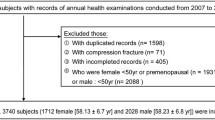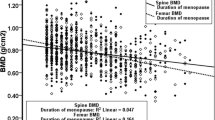Summary
The purpose of this study was to determine whether bone mineral density (BMD) measurements at the lumbar spine and femoral neck provided comparable information to women planning to use that knowledge to help them make a decision about hormone replacement therapy. Eighty-eight healthy Caucasian women, aged 44–59 and within 0 to 5 years of menopause, participated in the study. BMD measurements were performed at the lumbar spine (L1-L4) and the femoral neck by dual energy X-ray absorptiometry (DXA). Criteria suggested by the National Osteoporosis Foundation were used to categorize women as “at risk” for osteoporosis, bone density more than one standard deviation (SD) below the young adult mean, or as “low risk”, bone density at or above this level. The re that 46 women would be classified into the low risk category on the basis of spinal BMD alone. However, 28 of these 46 women would fall into the at risk category when the femoral neck BMD was measured. Sixty-one percent of women informed they were at low risk on the basis of spinal BMD would be considered at risk based on femoral neck BMD. When femoral neck BMD was used as the primary risk indicator, 14% of the women classified as low risk would be at risk if spinal BMD were added. These results suggest that both lumbar spine and proximal femur measurements should be made when women are using bone density measurements as an aid in deciding whether or not to use hormone therapy in their postmenopausal years.
Similar content being viewed by others
References
Riggs BL, Melton LJ (1986) Involutional osteoporosis. N Engl J Med 314:1676–1686
Riggs BL, Melton LJ (1983) Evidence for two distinct syndromes of involutional osteoporosis. Am J Med 75:899–901
Lindsay R, Hart DM, Forrest C, Baird C (1980) Prevention of spinal osteoporosis in oophorectomised women. Lancet 2:1151–1154
World Health Organization (1981) Research on the menopause. WHO technical report #670, World Health Organization, Geneva
Colditz GA, Stampfer MJ, Willett WC, Hennekens CH, Rosner B, Speizer FE (1990) Prospective study of estrogen replacement therapy and risk of breast cancer in postmenopausal women. JAMA 264:2648–2653
Consensus Development Conference (1991) Prophylaxis and treatment of osteoporosis. Am J Med 90:107–110
Wasnich RD, Davis JW, Ross PD (1990) Appropriate clinical application of bone density measurements. JAMA 45:99–102
Wasnich RD (1987) Fracture prediction with bone mass measurements. In: Genant HK (ed) Osteoporosis update. Radiology Research and Education Foundation, San Francisco, pp 95–101
Johnston CC, Melton LJ, Lindsay R, Eddy DM (1989) Clinical indications for bone mass measurements. J Bone Miner Res 4 (suppl 2):1–28
Wasnich RD, Ross PD, Heilbrun LK, Vogel JM (1987) Selection of the optimal skeletal site for fracture risk prediction. Clin Orthop Rel Res 216:262–269
Need AG, Nordin BEC (1990) Which bone to measure? Osteop Int 1:3–6
Mazess RB, Barden H, Ettinger M, Schultz E (1988) Bone density of the radius, spine, and proximal femur in osteoporosis. J Bone Miner Res 3:13–18
Rencken ML, Murano R, Drinkwater BL, Chesnut CH (1991) In vitro comparability of dual energy x-ray absorptiometry (DEXA) bone densitometers. Calcif Tissue Int 48:245–248
Lai KC, Goodsitt M, Murano R, Chesnut CH (1992) A comparison of two dual-energy x-ray absorptiometry systems for spinal bone mineral measurement. Calcif Tissue Int 50:203–208
Lindsay R, Aitken JM, Anderson JB, Hart DM, McDonald EB, Clark AC (1976) Long-term prevention of postmenopausal osteoporosis by estrogen. Lancet 1:1038–1041
Stampfer MJ, Colditz GA, Willett WC, Manson JE, Rosner B, Speizer FE, Hennekens CH (1991) Postmenopausal estrogen therapy and cardiovascular disease: ten-year follow-up from the Nurses' Health Study. N Engl J Med 325:756–762
Melton LJ, Atkinson EJ, O'Fallon WM, Wahner HW, Riggs BL (1991) Long-term fracture risk prediction with bone mineral measurements made at various skeletal sites. J Bone Miner Res 6 (suppl):S136
Wasnich RD, Ross PD, Davis JW, Vogel JM (1989) A comparison of single and multi-site BMC measurements for assessment of spine fracture probability. J Nucl Med 30:1166–1171
Cummings SR, Black DM, Nevitt MC, Browner W, Cauley J, Ensrud K, Genant HK, Palermo L, Scott J, Vogt TM (1993) Bone density at various sites for prediction of hip fractures. Lancet 341:72–75
Pocock NA, Sambrook PN, Nguyen T, Kelly P, Freund J, Eisman JA (1992) Assessment of spinal and femoral bone density by dual x-ray absorptiometry: comparison of Lunar and Hologic instruments. J Bone Miner Res 7:1081–1084
Author information
Authors and Affiliations
Rights and permissions
About this article
Cite this article
Lai, K., Rencken, M., Drinkwater, B.L. et al. Site of bone density measurement may affect therapy decision. Calcif Tissue Int 53, 225–228 (1993). https://doi.org/10.1007/BF01320905
Received:
Revised:
Issue Date:
DOI: https://doi.org/10.1007/BF01320905




